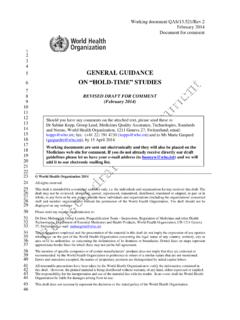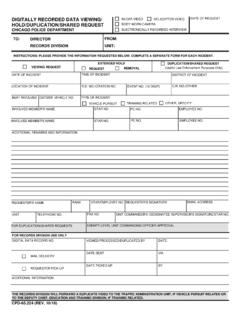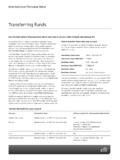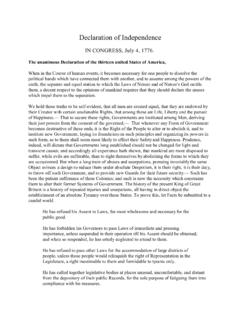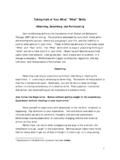Transcription of GENERAL GUIDANCE FOR INSPECTORS ON “HOLD …
1 Working document February 2013 RESTRICTED GENERAL GUIDANCE FOR INSPECTORS ON hold - time STUDIES DRAFT FOR COMMENT _____ World Health Organization 2013 All rights reserved. This draft is intended for a restricted audience only, the individuals and organizations having received this draft. The draft may not be reviewed, abstracted, quoted, reproduced, transmitted, distributed, translated or adapted, in part or in whole, in any form or by any means outside these individuals and organizations (including the organizations' concerned staff and member organizations) without the permission of the World Health Organization. The draft should not be displayed on any web site. Please send any request for permission to: Dr Matthias Stahl, Prequalification of Medicines Programme, Medicines Quality Assurance Programme, Quality Assurance and Safety: Medicines, Department of Essential Medicines and Pharmaceutical Policies, World Health Organization, CH-1211 Geneva 27, Switzerland; e-mail: The designations employed and the presentation of the material in this draft do not imply the expression of any opinion whatsoever on the part of the World Health Organization concerning the legal status of any country, territory, city or area or of its authorities, or concerning the delimitation of its frontiers or boundaries.
2 Dotted lines on maps represent approximate border lines for which there may not yet be full agreement. The mention of specific companies or of certain manufacturers products does not imply that they are endorsed or recommended by the World Health Organization in preference to others of a similar nature that are not mentioned. Errors and omissions excepted, the names of proprietary products are distinguished by initial capital letters. All reasonable precautions have been taken by the World Health Organization to verify the information contained in this draft. However, the printed material is being distributed without warranty of any kind, either expressed or implied. The responsibility for the interpretation and use of the material lies with the reader.
3 In no event shall the World Health Organization be liable for damages arising from its use. This draft does not necessarily represent the decisions or the stated policy of the World Health Organization. Should you have any comments on the attached text, please send these to Dr Sabine Kopp, Manager, Medicines Quality Assurance Programme, Quality Assurance and Safety: Medicines, World Health Organization, 1211 Geneva 27, Switzerland; e-mail: fax: (+41 22) 791 4730 and to Ms Marie Gaspard by 12 April 2013. Working documents are sent out electronically and they will also be placed on the Medicines web site for comment. If you do not already receive directly our draft guidelines please let us have your e-mail address (to and we will add it to our electronic mailing list.)
4 Working document page 2 SCHEDULE FOR THE ADOPTION PROCESS OF DOCUMENT GENERAL GUIDANCE FOR INSPECTORS ON hold - time STUDIES Date Preparation of draft by Dr van Zyl, South Africa, based on need identified by the WHO Prequalification Programme INSPECTORS November-December 2012 Preliminary internal review of draft January 2013 Draft mailed for comments February 2013 Collation of comments April 2013 Review by INSPECTORS collaborating with the WHO Prequalification Programme May 2013 Recirculation for comments June 2013 Collation of comments September 2013 Presentation to forty-eighth meeting of the WHO Expert Committee on Specifications for Pharmaceutical Preparations 14-18 October 2013 Further follow-up action as required Working document page 3 CONTENTS Introduction and background Scope Introduction and background Manufacturers should ensure that
5 The products that they manufacture are safe, effective and of the quality required for their intended use. Products should be consistently manufactured to the quality standards appropriate to their intended use and as required by the marketing authorization. Systems should ensure that pharmaceutical products are produced according to defined procedures that are validated and monitored. Manufacturing processes should be shown to be capable of consistently manufacturing pharmaceutical products of the required quality that comply with their specifications. Arrangements should exist to ensure that the materials used, intermediate products, bulk and finished products are stored under appropriate conditions.
6 Storage should not have any negative effect on the processing, stability, safety, efficacy or quality of the materials, intermediate products, bulk and finished products. Good manufacturing practices require that the maximum allowable hold time should be established to ensure that in-process and bulk product can be held, pending the next processing step, without any adverse effect to the quality of the material. These time periods must be supported by adequate data to demonstrate that the product will be stable throughout the approved shelf-life. Normally bulk products should not be stored for a period of 25% or more of the approved shelf-life (prior to packing into the final containers) unless these are tested, with stability-indicating methods, prior to packaging.
7 Working document page 4 Scope This document does not intend to prescribe a process for establishing hold times, but reflects aspects that should be considered in the design of the hold - time study. Manufacturers should gather sufficient data to demonstrate that a product: - remains stable before processing to the next stage; - meets the acceptance criteria for the finished product; - meets its stability specifications. The quality and stability of starting materials, intermediate products, bulk and finished products should be ensured at all stages of manufacture. Maximum allowable hold times should therefore be established for starting materials, intermediate products, bulk and finished products on the basis of tests related to storage conditions.
8 Data to justify the hold time can be collected during development on pilot scale batches, during process validation, or as part of a deviation with appropriate testing. hold - time studies establish the time limits of holding the materials at different stages of production by assuring that the quality of the product does not deteriorate during the hold time . To validate the hold time under the specified hold - time condition, results obtained should be within the limits of acceptance criteria throughout the hold time . hold times should be determined prior to marketing of a product and following any significant changes in processes, equipment, packaging materials, etc. Manufacturers may use a flow chart to review the manufacturing procedure of a product and then break up the critical stages of manufacturing process on the basis of time duration required for the particular processing stage and the impact of time period with reference to environmental conditions and storage conditions.
9 Working document page 5 Generally, for oral solid dosage forms, the following stages should be considered: - binder preparation to granulation; - wet granulation to drying; - dried granules to lubrication/blending; - lubrication/blending to compression; - compression to coating; - aqueous coating solution preparation to coating; - coating to packing. A written protocol, procedure or programme should be followed which includes elements and test parameters appropriate to the material or product under test. The protocol and report should include a title, reference number, version, date, objective, scope, responsibility, procedure, description of the material/product, sample quantities, sampling method and criteria, acceptance limits, frequency for sampling, sampling locations, pooling of samples, storage conditions, type of container, methods of analysis, results, conclusion, recommendation, signatures, dates, etc.
10 Typically one or more batches of a material, intermediate or product can be used for determining hold times. A representative sample of the batch of material or product subjected to the hold - time study should be held for the defined hold period. The maximum storage period for each category of material should be established on the basis of the study by keeping the material in a simulated container used in production. The containers used in which hold - time samples are stored should be of the same material of construction as those used in manufacturing/quarantine. hold - time samples should have head space in proportion to bulk stored in manufacturing/quarantine. The sample storage environmental conditions should be same as that of the quarantine area/manufacture stage.










